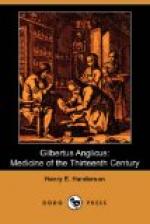R.
Seminis papaveris albi et nigri,
Seminis lactucae, aa. ounce I.
Opii,
Misconis ( , poppy juice?),
aa. scruples I-II, as
required.
The patient is to be aroused as before.
On folio 180d we find a chapter entitled “De cathena gulae incisa vel fracta,” and copied almost literally from the chapter “De catena gulae” of Roger. In neither writer do I find any precise definition of what the cathena gulae is, though Roger says, Si es gulae, quod est catena, fractum fuerit, etc., nor do I find the terms used explained in any dictionary at present available. The description of the treatment of this fracture seems, however, to indicate that the catena gulae of Roger and Gilbert is what we call the clavicle, though the more common Latin names of this bone are claviculus, furcula, juglum or os juguli. Gilbert says: “But if the bone which is the cathena gulae is broken or in any way displaced (recesserit), let the physician with one hand raise the forearm (brachium) or arm (humerum) of the patient, and with the other hand press down upon the projecting portion of the bone. Then apply a pledget moistened with albumen, a pad and a splint in form of a cross, and over all a long bandage embracing both the arm and the neck and suspending the arm. A pad (cervical) should also be placed in the axilla to prevent the dropping of the arm, and should not be removed until the fracture is repaired. If the fracture is compound, the wound of the soft parts is to be left open and uncovered by the bandage, so that a tent (stuellus) may be inserted, and the wound is then to be dressed in the ordinary manner.”
Simple fracture of the humerus, Gilbert tells us, is to be reduced (ad proprium locum reducator) at once by grasping the arm above and below the seat of fracture and exercising gentle and gradual extension and compression. Then four pieces of lint wet in egg-albumen are to be placed around the arm on all sides, a bandage, four fingers wide, also moistened in albumen is to be snugly applied, another dry bandage placed above this, and finally splints fastened in position by cords. This dressing is to remain undisturbed for three days, and then renewed every third day for nine days. After the ninth day a strictura (cast, apparatus immobile?) is to be prepared and firmly applied with splints and a bandage, and the patient is to be cautioned not to bear any weight upon the injured arm (ne infirmus se super illud appodiet?). The fracture is then left until it is believed that consolidation has occurred. If, however, it is found that swelling is occasioned by the cast (ex strictorio?), the latter should be removed, and the arm well bathed in warm water containing mallowae and other emollients and thoroughly cleansed. If the bone seems to




